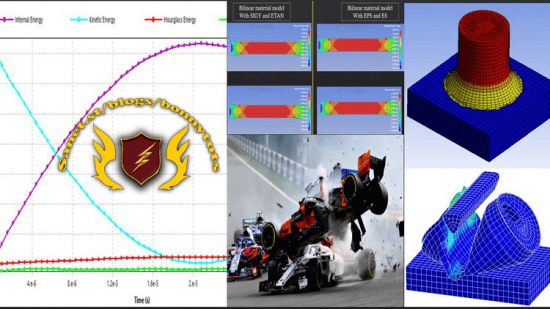
Published 11/2022
MP4 | Video: h264, 1280×720 | Audio: AAC, 44.1 KHz, 2 Ch
Genre: eLearning | Language: English | Duration: 33 lectures (6h 56m) | Size: 5 GB
A comprehensive course on LS-DYNA using practical examples and calculations
What you’ll learn
Understanding difference between Implicit and Explicit Analysis.
Different types of analysis.
FE model building using LS-PrePost.
Contact and material modelling,
Spot weld modelling strategies for LS-Dyna,
Concept of hourglass and timestep,
Non-linear dynamic analysis,
Various projects with post-processing strategies.
Requirements
No prior experience is required. Everything that is required to get going with LS-Dyna will be covered in this course.
LS-Dyna Solver
Description
Hello learners,
I welcome you all to this comprehensive course on LS-DYNA. Objective of this course is to get started from very basic understanding of FEA and gradually get you well versed with LS-DYNA. LS-DYNA is one of the most best and popular explicit code out there. LS-DYNA is used in almost all the industries that you can imagine. In this course though we will be taking examples of only structural analysis from automotive domain.
Skills you will gain at the end of the course
You will learn different types of analysis and fundamental difference between them.
You will learn to setup a model in LS-PrePost, edit the model in Notepad++ and solving the model using LS-Dyna.
You will learn various aspect of material modelling in LS-Dyna.
You will get overall understanding of important concepts in explicit such as hourglassing, timestep and mass scaling.
Brief outline of the course is as following
1. FEA/CAE basics and types of simulation
Product life cycle management
Branches of CAE
Intuition of CAE
Steps in CAE
Types of analysis.
2. Introduction to LS-PrePost
Deep dive into preprocessing using LS-PrePost.
GUI of LS-PrePost.
Handling a model using different approaches.
3. Keyword Arrangement in LS-Dyna
Running a simple simulation
File format and keyword structure in LS-Dyna.
Keyword Arrangement : Nodes and Elements
Keyword Arrangement : Parts, Section, Material
LS-Dyna Manuals
Example : Cube Under Pressure
Keyword Arrangement : Database and Control
Keyword Arrangement : Boundary and Constrained
4. Material Modelling for LS-Dyna
Material Non-Linearity
Conversion of Engineering Stress, Strain to True Stress, Strain
Material : MAT024 PIECEWISE LINEAR PLASTICITY
Example : Tensile Test with Non-Linear Material
5. Important Keyword
*Include
Example : Include File Structure
Introduction to Hourglass
Examples on Hourglassing and control
TimeStep
New topics and projects are coming soon
Who this course is for
Mechanical Engineers
Meshing Engineers
CAE Analysts
Automobile Engineers
People who are working in CAE/CAE
Password/解压密码www.tbtos.com
转载请注明:0daytown » A Detailed Introduction to LS-Dyna for Structural Analysis